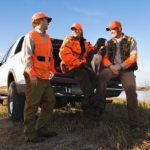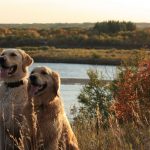By Steve Smith
Men trifle with their politics,and they trifle with their careers, but they do not trifle with their sport.
Try this—Walk into a tavern and announce in this order:
“Anyone who voted for George Bush is a jerk.”
“Anyone who dropped out of college is a loser.”
“Anyone who spends time walking behind a hunting dog is an imbecile.”
See which one of those gets you punched in your mouth.
the other guy’s dogYou see, when it comes to gun dogs, upland shooters and waterfowl hunters have never been wired up exactly like they should be—haven’t been since Canis lupus became Canis lupus familiaris and moved into the family cave on this side of the fire—and probably up onto what passed for the Cro-Magnon edition of the good sofa.
I know one guy who has a female Lab that won’t stay in range, chases birds, eats the few my pal manages to scratch down, and at nine-years-old hasn’t quite got the housebroken thing mastered. He dotes on her. The same guy is just finishing up a divorce to his third wife; I think it was this one couldn’t get the toothpaste cap drill right. I forget. Anyhow, you get the picture.
Now, it stands to reason that if you aren’t used to hunting with dogs, you should realize there are several types. There are those that find and point game—pointing breeds; there are those that find and retrieve downed birds—retrieving breeds; there are those that find and flush birds for the gun—flushing breeds.
Now on any given day, the lines can become blurred. Dogs that are supposed to point will flush, the retrieving breeds will sometimes even point, and all of them are supposed to retrieve after a fashion, even though only the retrieving breeds are supposed to do it with any degree of reliability.
The lines get even fuzzier when the retrievers and the pointers and the flushers get wrapped up into one package called the “versatile” dog of Continental extraction, which means the mutt will flush when he should point, point when he should be chasing, and eat the birds you shoot like God’s going to stop making them.
Then there’s the type not often discussed: The Other Guy’s Dog… a breed apart. You see, there is something special about The Other Guy’s Dog, and you have to realize that right off. I mean, you can go to this man’s house and he hands you his newborn son to fondle. You can turn up your lip, recoil and cringe, and mutter something like, “Get that little bleeper away from me—he’s all sticky,” and the guy will shrug his shoulders and lateral the kid off to his wife. But comment after a couple of drinks that the guy’s 2,000-pound Chesapeake is cutting the circulation off to your knees after sitting on your lap for the last four hours, and he shows you the door. And I mean right now.
Take my pal Greg Frey. Frey has a mutt name of Sam—big English setter. Dog’s a moron. Everybody knows it, including Frey. Frey got him as the result of a bet he lost or something. Or, maybe he’s serving community service for kiting a check or shoplifting or something a few years back. That’s the only explanation for the bond between Greg and this beast. Sam has two talents, the same two exhibited by English setters everywhere: eating and sleeping. Sam’s world-class. Except, that’s all he does.
Oh, Greg takes him hunting, all right. Sometimes when I scrape up the nerve or I can’t get out of it, I go with them. We hunt grouse and we hunt woodcock. Mostly, we hunt for Sam, who gets out of the truck and just sort of leaves the township. About every 20 minutes, Greg starts shrieking at Sam, takes off through the cover like he was catapulted, and tackles Sam, who evidently has pressing business just this side of Magnetic North. They wrestle in the leaves for a bit, and Greg wins because he’s in better shape. Then, Sam hunts for a while—maybe even points, although that’s no guarantee he smelled anything or knows even a trifle more than we do about the whereabouts of any birds. Then, Sam wanders off, and the scene is repeated. But if you can stay with Greg when he goes after Sam, you’ll get some shots, because, bounding through the brush and leaping windfalls, Frey’s the best flusher I ever hunted with. Hands down.
Now, naturally, I don’t criticize old Sam. He’s doing the best he can with what he’s got, poor thing. And besides being unfair to the dog, criticism would have a tendency to set Greg’s teeth on edge to the point that you can watch the enamel splinter. You see, he doesn’t trifle with his sport either.
Spotting a felon among the changing cast of canine characters you’ll hunt with in a year is easy, once you know what to look for in The Other Guy’s Dog. First tip: The name. Now, folks who run a lot of dogs over the years have sort of run out of dog names, so they give them people names: Fred, Bill, Sally, Poindexter—you know. A dog handler at a Southern plantation with 50 dogs doesn’t have time to sit around and think up cutesy names.
But, our hero is different. The cuter, more autumn-is-the-smoky-colored-umber-smelling-earth-in-its-majesty sounding the name is, probably the worse the dog is. The inverse is usually true also; the simpler the name, the better the dog because he’s been trained and named by a guy who ran out of those sweet little labels 30 dogs ago. There are exceptions (see “Sam” above) both ways, but it’s a good starting rule of thumb.
For example, if your hunting pal introduces you to his new Lab “Misty Morning,” “Missy” for short, be ready for the canine equivalent of the Hillside Strangler. Good Labs are named like “Maggie” and “Tar” and “Jake.” If a man who invites you hunting has a chiseled-headed setter that looks like an Osthaus painting and has a name like “October Delight,” think about spending that particular Saturday at the Christian Science Reading Room.
There aren’t many things I know too much about, but I learned a long time ago not to verbalize my true opinions of The Other Guy’s Dog. You’ll forgive me if I give you this advice without letting you in on the exact details that give me the right to give it. Trust me when I tell you it is hard-won knowledge I paid for in dashed friendships, bad hunting trips, and the odd rearranged facial feature. Innocent little remarks on my part, I tell you, but the opposition has no sense of humor. I have yet to meet the dog owner who trifles with his sport. So, for your enlightenment, here’s the advice: Develop an alternative vocabulary, commit it to memory, and use it to discuss The Other Guy’s Dog with him. Use these terms only when called upon. Volunteer nothing.
Good range. This means the dog can actually be seen on clear days. If you’re on a hill and he’’ passing over the next. Replaces previous usages “coyote” and “smoker.”
Thorough. This refers to the dog that thinks the birds are most likely found between your feet or eight yards behind you. Avoid here use of the terms “boot-licker” and “gunshy.”
Intensity. Another term you can use to admire The Other Guy’s Dog. This is best used after you’ve had a tug-of-war to get a bird away from him, probably the only grouse you’ll shoot all season. Substitute for “hardmouth,””lamebrain,” “jarhead.”
Good conformation. Use this when the dog at least seems to vaguely resemble any one of the following: the sire/the dam/the breed/a dog. Avoid at all costs discussions of “papers,” “AKC,” and “Field Dog Stud Book.”
Steady. Admire the mutt’s “steadiness” if you notice he has a tendency to doze off while on point or if a retriever, spends his time on a duck hunting sleeping in the boat.
Drive/Fire. These can be used interchangeably in referring to a dog who can’t stay on the ground when birds are in the air. To The Other Guy, “steady to wing and shot” and “checkcord” might as well be “byziliop nugerlow epilimbot.”
People-oriented. This means the dog will spend at least a portion of what he considers down time in the field trying to hump your leg. Admire his friendliness. Comment on how he’s “bonded” with humans. Kick him when The Other Guy isn’’ looking.





